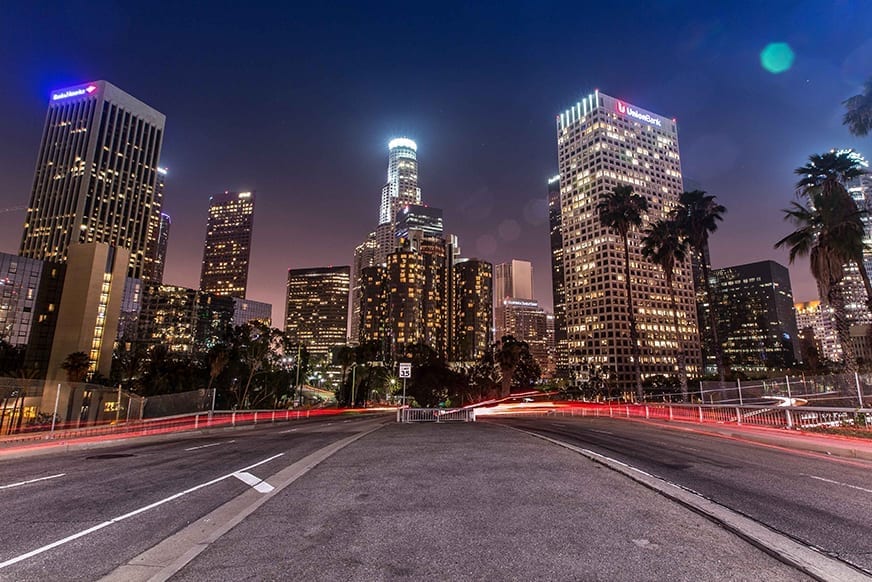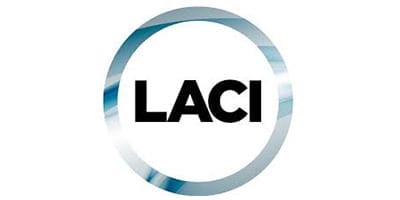LA is one of the most traffic-choked cities in America, and suffers from some of the worst air pollution in the nation. This has been exacerbated by a recent threefold rise in e-commerce deliveries, with diesel-powered delivery trucks exacerbating both congestion and pollution. However, change is coming for the better on both fronts, thanks to the vision of both the Mayor of Los Angeles and the many public and private stakeholders across the region. Many voices are calling for a zero emissions delivery zone—and LACI believes a pilot project zero emissions delivery zone is a key milestone for LA.
The Transportation Electrification Partnership
LACI and many other organizations are working on revolutionizing transportation and mobility in LA—and one of the major steps they have taken together is to create the Transportation Electrification Partnership (TEP). TEP brings together local government officials, utilities, state regulators, industry leaders, and startups to reduce greenhouse gas (GHG) emissions and air pollution in the greater Los Angeles region by accelerating transportation electrification and zero emissions goods movement by 2028, the year that the Olympic and Paralympic games arrive in Los Angeles.
TEP brings together stakeholders to reduce emissions by accelerating transportation electrification and zero emissions goods movement.
An Emission Reduction Roadmap for Los Angeles
In order to meet the aggressive targets of the partnership, TEP launched its Roadmap 2.0 report in November 2019, articulating how to achieve an additional 25% reduction in GHG emissions and air pollution in the LA region. In particular, the Roadmap calls for 60% of medium-duty delivery trucks in LA County to be electric by 2028.
This goal aligns seamlessly with other Los Angeles goals linked to medium-duty trucks. The City of Los Angeles, for example, has committed to a zero emissions zone covering people and goods movement by 2030 in partnership with the global nonprofit C40. Moreover, LA’s Green New Deal calls for 100% of urban delivery vehicles to be zero emission by 2035.
Given that there are just a handful of zero emissions medium-duty trucks on the road today, how are we going to reach the TEP goal of 60% electric medium-duty trucks in just eight years?
Emissions from E-Commerce on the Rise
The existing medium-duty trucks on the road in LA County come in many different forms, but most of them are involved in supporting goods delivery, including the all-important last-mile delivery. While economically vital, these trucks pose a public health hazard, as they are frequently powered by diesel, whose emissions are linked to any number of health problems, from asthma to lung cancer.
With just a handful of zero emissions trucks on the road today, how do we reach 60% electric medium-duty trucks in just eight years?
And the challenge with medium-duty trucks is only getting worse, thanks to the skyrocketing growth of e-commerce. The World Economic Forum estimates that “without any intervention, the number of delivery vehicles in the top 100 cities globally will increase by 36% until 2030. Consequently, emissions from delivery traffic will increase by 32% and congestion will rise by over 21%, equaling an additional 11 minutes of commute time for each passenger every day.”
Given these challenges, it is clear that an intervention is needed, one that tackles both the health risks posed by medium-duty trucks, but also the congestion challenges exacerbated by last-mile delivery.
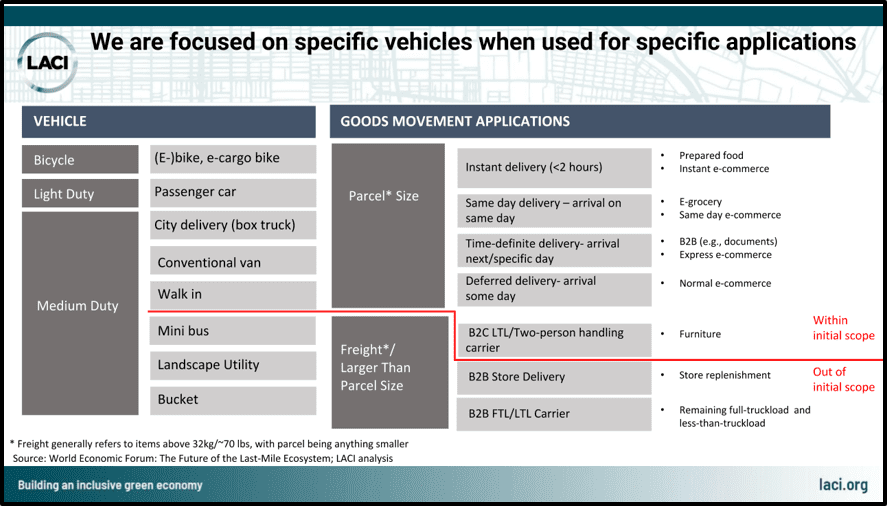
Piloting a Zero Emissions Goods Delivery Zone
To jumpstart progress on this intervention, LACI proposes that LA adopt a zero emissions goods delivery pilot zone in the early 2020s, a precursor to the zero emissions goods and people movement zone that will be in place by 2030. Taking the lead of access zones pioneered in Europe and Asia, Los Angeles could pilot a zone, covering a 1-3 mile radius, with the voluntary participation of major players in last-mile delivery.
A zero emissions goods delivery pilot zone in the early 2020s would be a precursor to the zone that will be in place by 2030.
The timing of the pilot would coincide with the commercial arrival of electric medium-duty trucks, whether from legacy players like Peterbilt, BYD, and Mitsubishi Fuso, or from a growing number of startups like Arrival, Rivian, XOS, Chanje, Workhorse, and CityFreighter. It would also coincide well with the growth in e-cargo bike sales in the US, particularly for use in fleets for goods delivery.
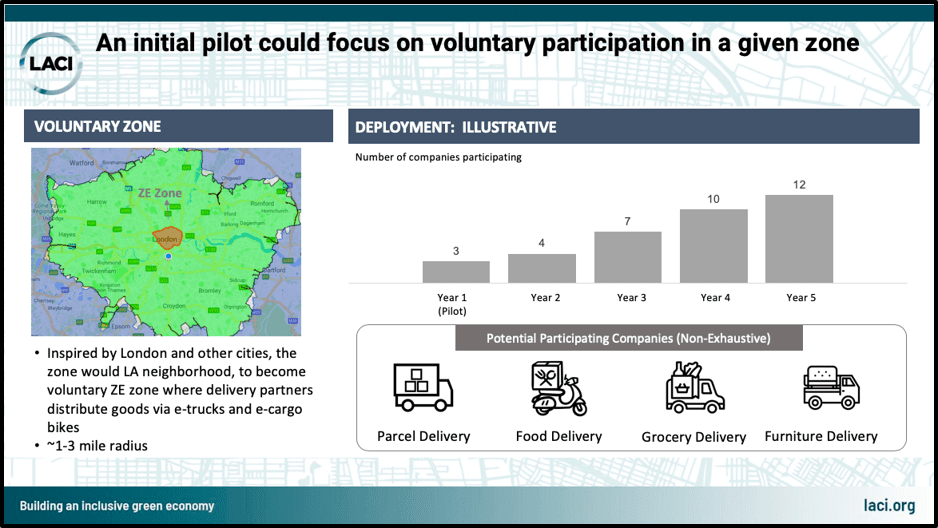
Tackling an Ambitious Goal
Of course, pulling off such a pilot will take both smart thinking and strong execution. Decision-makers will need to consider a range of policy carrots and sticks to help ensure that the right incentives are in place, including the all-important notion of curb access for zero emissions vehicles vs. non-zero emissions vehicles. Those running the pilot will need the right initial delivery partners and they will need to make certain the zone has the optimal density and radius. And finally, we will have to ensure that sufficient infrastructure for both electric medium-duty trucks and e-cargo bikes are in place.
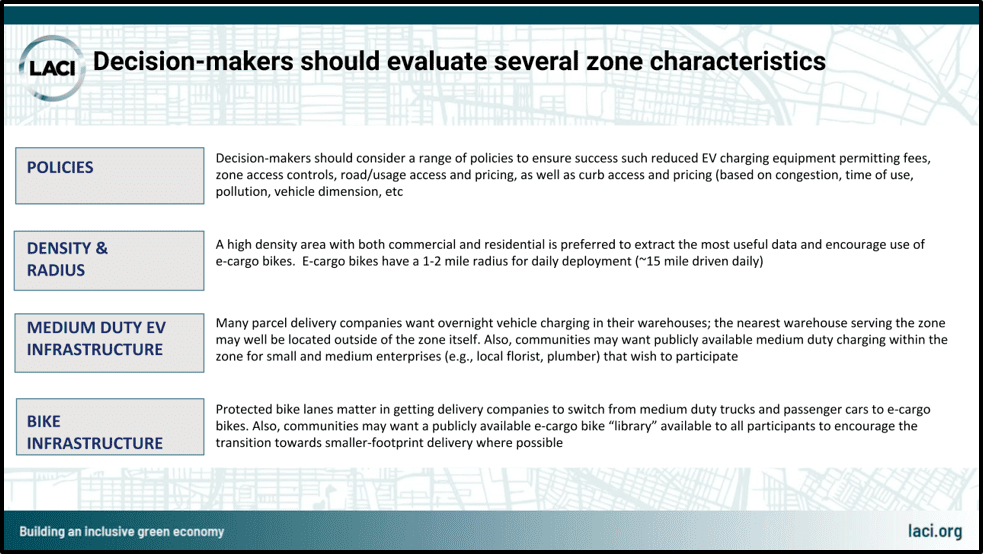
A pilot of this nature could jumpstart progress towards the TEP 2028 goal. We expect it will allow cities in Southern California and across the nation to develop the confidence to mandate zero emission delivery zones and the phase-out of medium-duty diesel trucks. It should also allow cities and corporations to develop “ahead of the curve” logistical and operational best practices involved in a zero emissions delivery zone, including the deployment of smaller footprint delivery methods, such as e-cargo bikes.
A zero emissions goods delivery pilot zone should allow cities and corporations to develop “ahead of the curve” best practices.
Residents should benefit from such a pilot as well. The pilot should ensure a reduction of GHG emissions and improve local air quality and health via a reduction in diesel air pollutants. Moreover, if smaller footprint vehicles such as e-cargo bikes are incorporated into the pilot, locals should benefit from a decrease in local traffic congestion and delivery times.
So what’s next? Stay tuned. We’re just getting started.

